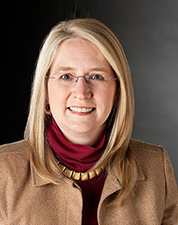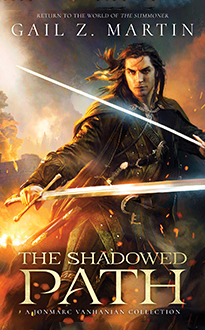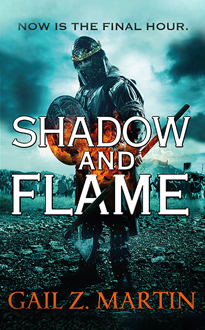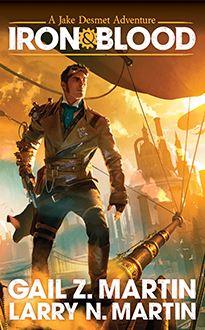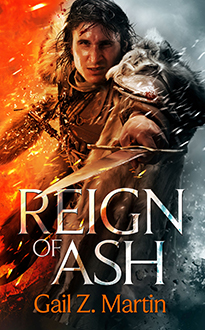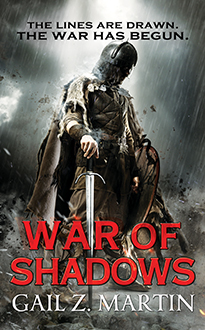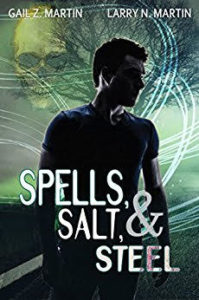by Gail Z. Martin
I mostly write about necromancers who are good guys.
Tris Drayke, the main character in my Chronicles of the Necromancer/Fallen Kings Cycle series, struggles to control his power as he rises to be the strongest Summoner of his generation. Tormod Solveig, a secondary character in my Ascendant Kingdoms series, wields his power as a warlord and a necromancer with his sister Rinka, a fearsome warrior, watching his back. Archibald Donnelly, in my Deadly Curiosities dark urban fantasy series, takes the low key approach to necromancy with the misleading demeanor of a laid back archivist. They’re the good guys, wrestling with the temptations of fearsome power to remain on the side of light.
Now let’s go dark side. In the steampunk world of Iron & Blood, which I co-write with my husband, Larry N. Martin, we meet the dark necromancers, the Resurrectionists, Francis Tumblety and Adolph Brunrichter, as well as the Dollmaker, who try to uncover the secrets of clockwork-driven immortality. Scaith, a dark necromancer, also appears in The Sworn and The Dread in my Chronicles/Fallen Kings series, and the devotees of the dark goddess Shanthadura also move into the territory of dark necromancy. In Vendetta, part of my Deadly Curiosities series, Sariel calls on dark magic to control reapers and nephilim who in turn feed on the spirits of the dead. And in The Shadowed Path, we meet Foor Arontala, a blood mage. He is not an necromancer himself, but he is sworn to freeing the soul of the Obsidian King, a powerful dark necromancer whose soul was imprisoned after he nearly brought the Winter Kingdoms to destruction.
Intent is everything.
I’ve written about hero necromancers because I don’t believe power is intrinsically good or evil; what matters is what you do with the power. And as Spiderman knows, with great power comes great responsibility. What makes the responsible use of great power very difficult is imperfect information and human nature. Without complete information, it’s easy to draw incorrect conclusions, come to bad decisions, and believe you’re using the power to do the right thing when in fact, you’ve been badly misled. Worse, dire circumstances can tempt the best people to wonder if in this particular case, the end justifies the means. And of course, ego, denial, fear, anger, and the need for vengeance can blind us and send us down the road to hell with plenty of good intentions.
Which means that to remain serving the Light, a necromancer must be as vigilant about his/her actions as about the threats from the enemy. More so, perhaps, because self-delusion is easy and comfortable and the consequences of wrong choices affect both the living and the dead.
So the distinction that I draw between good and evil when it comes to necromancy comes down to respect for free will and volition. A necromancer who serves the Light will not force an unwilling spirit into a dead body, nor trap a spirit in a corpse that wants to be free. He or she will not keep a spirit from crossing to its final rest, nor trouble the spirits of the dead for personal gain or selfish reasons.
A good necromancer might call summon the spirits of the dead to learn information that benefits the larger whole. In battle, he/she might make it possible for the willing spirits of dead soldiers to reanimate their corpses or give their ghosts form and substance to fight. It is permitted to bind a spirit that wants to be healed to its dying body long enough for the body to be healed. A Light necromancer would be duty-bound to release spirits held against their will by curses or Dark magic.
So what about Dark necromancy? That gets into ‘evil legions of the undead’ territory. Dark necromancers are willing to use the souls of the dead and their ravaged corpses as shock troops, or to bind the souls of tortured and broken prisoners to their dying bodies and send them first into battle as sword fodder. The darker side of necromancy traps spirits and forces them into servitude, either as revenants or as zombies. Dark necromancy acts for selfish purposes and the aggrandizement of power without regard for agency, free will or self-determination.
Dark necromancy considers the spirits of the dead to be tools, nothing more than means to an end, without respect for them as human beings or immortal souls. A dark necromancer may serve a god or goddess and/or owe a deity a debt for assistance, but the practice of dark necromancy essentially sets the mage outside of and above humanity by meddling with human souls. Dark necromancy, in my worlds, is tied to blood magic, which requires forbidden magic and usually either human or animal sacrifice. Once again, intention is key, since the willingness to sacrifice another living being for the accumulation of power marks and sullies the soul of the practitioner.
In the end, the same choices that make a dark necromancer also make a monstrous human being: the disregard for freedom of choice and the value of human life.

